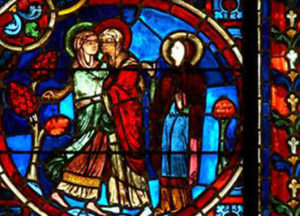Anglican worship is essentially liturgical, and is the primary way Christians have worshiped since antiquity. At All Saints, we believe the liturgy is an ideal vehicle for worshiping God “in Spirit and Truth.” That said, we recognize that this may be strange or unfamiliar for many of our visitors. Below are some elements of worship you will encounter as you join us at All Saints:
Book of Common Prayer
Since the time of the Reformation, the most distinctive aspect of Anglican worship has been the use of the Book of Common Prayer. In this masterpiece of liturgy, we find everything needed to worship God as a community in a single volume. At All Saints, we use the American 1928 edition of the Prayer Book, with its classical Anglican patterns and robust theology rooted in both the Reformation and the ancient Church.
Hymnody
At All Saints, we use the Book of Common Praise (Anglican House Publishers, 2017), a collection of the Church’s best music from the first millennium through the current century. We also sing much of the service, regularly chant the psalms, and generally love to lift our voices to God in congregational singing.
Vestments
Following the ancient Western Christian tradition, the clergy, servers, and choir wear special clothing during worship. These vestments have their roots in the clothing of late antiquity, but have taken on special significance and symbolism over the centuries. The basic vestment is the white alb (i.e. robe) or surplice (loose garment worn over the black cassock). This is reminiscent of the white robes given to new converts at their baptism, symbolizing being washed clean from our sins by Christ’s blood. Other vestments used by the priests include the scarf-like stole (symbolizing the promise of everlasting life) and the poncho-like chasuble, representing the yoke of Christ. These are usually colored according to the liturgical seasons.
Icons
Anglicanism is essentially an incarnational expression of Christianity, in which we recognize that God has not only made all that we touch and see but that he became touchable and visible in Christ. One of the Church’s traditional expressions of this incarnational reality is the painting or “writing” of icons. At All Saints, we ornament the chapel with icons of Christ and the biblical saints as the “family portraits” of the Church. We remember these saints as those who are triumphantly before the Lord in heaven, praying for us as we continue our earthly pilgrimage (see Revelation 8:4).
Incense
Since Old Testament times, God’s people have used incense in worship. In fact, in St. John’s vision of the Heavenly Throne, the smoke of incense is being offered to God, symbolizing the prayers of God’s people (Revelation 5:8). At All Saints, we follow this example at the later service on Sundays and on most Holy Days, further engaging all the senses in worship.
Preaching and Scripture
While we don’t usually think of preaching in these terms, the sermon is also an essential part of our worship, especially since the Reformation. In proper preaching, the truths from the Bible are brought out for all the congregation to see. At All Saints, we preach both Law and Gospel from the Scriptures, with the goal of exalting Jesus, edifying the Church, and saving souls (see Romans 10:4, 2 Timothy 3:16).
Not only do we preach from the Scriptures, but we also proclaim them in public reading at each service. In the readings from Holy Communion, we follow our Lord’s life through the Church year, using the same lessons from God’s Word that the Western Church has used for centuries. In the readings from the Daily Offices, we read through the greater part of the entire Bible each year.





